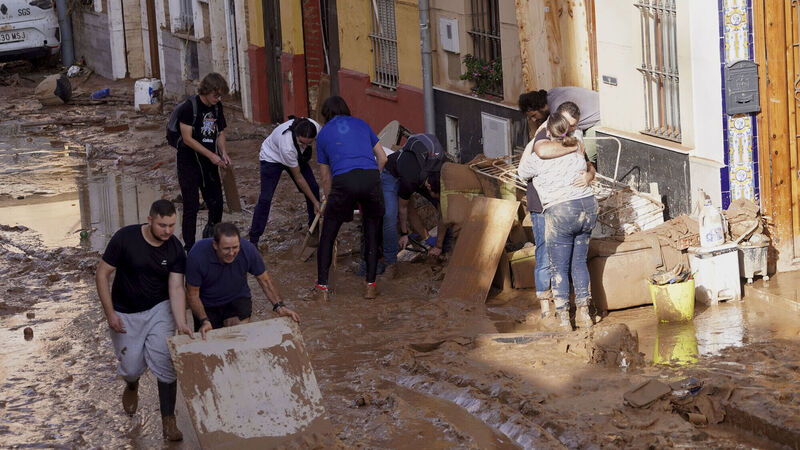Spain braces for torrential rain as new weather system reaches Med coast
4 min read
Residents clean their houses affected by floods in Valencia, Spain, Thursday, Oct. 31, 2024. (AP Photo/Alberto Saiz)

Residents clean their houses affected by floods in Valencia, Spain, Thursday, Oct. 31, 2024. (AP Photo/Alberto Saiz)
Two weeks after flash floods devastated parts of eastern Spain, the country is once again on high alert as a new weather front approaches, bringing torrential rain, low temperatures, and potential storms. Spain’s meteorological agency, Aemet, has issued an orange alert for several regions along the Mediterranean coast, warning of the possibility of severe weather from now until Thursday.
The eastern and southern parts of Spain, particularly the Valencia, Catalonia, and Andalusia regions, as well as the Balearic Islands, are the most vulnerable to the upcoming weather. Aemet has forecast “very strong to torrential” rainfall, which could lead to flooding and storm damage. The orange alert is the second-highest warning level, signifying a significant weather event that could disrupt normal activities. In some towns, military vehicles have been deployed, using loudspeakers to warn residents of the impending storms.
Local authorities have already begun taking precautions in affected areas. In parts of Valencia, schools and sports activities have been suspended, while sandbags have been piled up in the town of Aldaia to protect key areas from flooding. However, experts have emphasized that this new weather system, dubbed “Dana,” is not expected to be as catastrophic as the previous storm in late October, which caused unprecedented damage and loss of life.
That earlier storm, a powerful Dana weather system, led to flash floods that resulted in 222 confirmed deaths across Spain, with 23 people still missing. The storms caused severe material damage, particularly in the Valencia region, where entire neighborhoods were submerged. Many survivors have voiced frustration over the lack of timely government response, and tensions have risen in some areas, as illustrated by a hostile reception to officials, including King Felipe VI, who visited the region after the tragedy.
Dana weather systems are formed when a low-pressure area becomes “cut off” from the main flow of the jet stream, causing it to become stationary over the same area. This leads to prolonged rainfall over several days. The interaction between cold air high in the atmosphere and warmer Mediterranean air intensifies the storms, creating the conditions for heavy rainfall and potential flooding.
This week, parts of Andalusia have already been affected by the new weather front. On Monday night, severe rainfall caused flooding in the province of Almería, and a section of the A7 motorway had to be temporarily closed. Emergency services were called to rescue three people whose cars had been swept away by floodwaters and trapped beneath a bridge in the town of Vícar.
Aemet has advised residents in orange-alert areas to exercise caution, particularly near ravines and waterways, as these can become dangerously swollen, even if they appear dry. The national traffic office (DGT) has also urged people to check road conditions before traveling, as heavy rainfall could make driving hazardous. King Felipe VI is scheduled to visit a military base in Bétera, Valencia, where the armed forces are continuing the search for missing people and helping with clean-up operations.
While the new Dana system is not expected to be as extreme as the one in late October, the weather could still cause significant disruptions. The wettest areas, particularly around Málaga and Granada, could receive up to 180mm of rain this week, which is about two months’ worth of rainfall in just a few days. In addition to the heavy rain, large hail and gusty winds are also expected to pose a risk.
As the weather system moves across the Iberian Peninsula, the first significant snowfall of the season is also predicted. The Cantabrian mountains, Sierra Morena, and the Central and Betic mountain ranges are expected to see snow, with strong winds accompanying the wintry conditions. The combination of rain, snow, and wind could create hazardous conditions in both urban and rural areas.
Dana systems are not uncommon in Spain, typically occurring 10 to 20 times a year in the western Mediterranean. However, the recent series of severe storms has placed an increasing strain on emergency services and local governments. While this latest weather system is unlikely to match the scale of the destruction seen in late October, it serves as a stark reminder of the vulnerability of many regions to extreme weather events and the urgent need for effective preparedness and response strategies.
As Spain braces for more heavy rain and possible flooding, the country remains on edge, hoping that this second Dana will pass without causing further tragedy. With the region still recovering from the earlier devastation, the focus remains on saving lives, protecting property, and minimizing damage from the latest weather front.